There are two basic rules:
Ground Contact
Race Walking is a progression of steps so taken that the walker makes contact with the ground, so that no visible (to the human eye) loss of contact occurs.
In this example, the athlete may have both feet off the ground long enough for a judge to see the loss of contact.
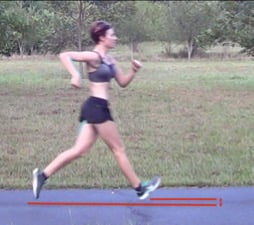
The rules require the racewalker to NOT have both feet off the ground at the same time for long enough for the unaided human eye to detect. A camera can capture fractions of a second of flight time imperceptible to the eye. Experienced judges see loss of contact at around 43 milliseconds. Runners have five to ten times this much loss of contact between ground contacts.
Straight-leg
The advancing leg must be straightened (i.e. not bent at the knee) from the moment of first contact with the ground until the vertical upright position.
The athlete on the left fails to comply with this rule. The athlete on the right is using legal technique.
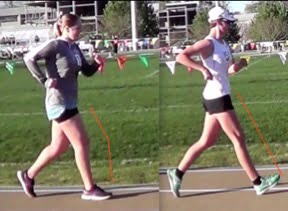
Much more common amongst beginning racewalkers is failure to have a straight knee at ground contact, or failure to maintain that straightness until the leg is upright.
Judges give the benefit of the doubt, but if they see an athlete is in danger of breaking either rule, they can show them a yellow paddle. There are paddles with an S shape to indicate the loss of contact rule, or a > shape to indicate the bent knee rule.
Loss of Contact

Bent Knee
Here we see a judge warning an athlete they are in danger of breaking the loss of contact rule. Yellow paddles are similar to brushing the bar in high jump without it falling. They do not lead to disqualification.
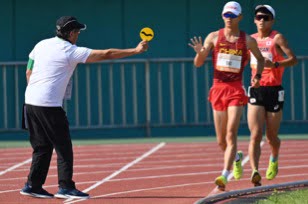
If a judge decides a racewalker is failing to comply with either rule, they will write a red card recommending disqualification.
Each judge may only write one red card for each athlete. If electronic communications are not in use, a card-runner will carry the cards to the DQ board, which is generally about 100 meters prior to the finish-line and arranged for viewing by the athletes during the race.
The recorder will put a red mark beside the athletes’ number.
In the picture, a card runner carries a red card from the judge to the recorder, who is positioned at the DQ board. If an athlete receives three red cards from three different judges, they have fouled-out and are removed from the race.
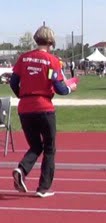
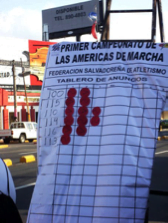
This is analogous to three failures in a field event. If the cards come in before the finish, the chief judge will indicate the athlete must stop by showing a red paddle. The judges record the yellow paddles and red card they issue on a tally sheet. These are signed and given to the recorder at the end of each race. The recorder crosschecks the number of red cards. Sometimes a third red card comes in after the athlete has finished. The chief judge must inform them that they were disqualified as soon as possible after the race. Judging calls are NOT appealable.
In races using a penalty box, which now includes all international events and some national level championships, a third red card leads to a time penalty spent in the penalty box. A fourth red card will lead to disqualification.
Video on how to judge racewalking:
https://youtu.be/QSJoZwRVSdc
Video on how the penalty box (pit lane) works:
https://youtu.be/tWto7gMLtn8
Additional Racewalk Judging Resources
Judging Racewalk
Summary Sheet
Judging Resources
Racewalk Certification
Candidates for Racewalk Official Certification must be a current USATF Official
in good standing.
Step1 : Complete the appropriate Racewalk Rules Review.
Paper Rules Review : Apprentice & Association
On-line Rules Review : Apprentice & Association
Paper Rules Review : National
Paper Rules Review : Master
Paper Rules Review : Racewalk Referee
Step 2: Submit the upgrade application to the Association Officials
Certification Chair. If taking the paper Rules Review, then be sure
to include that as well.